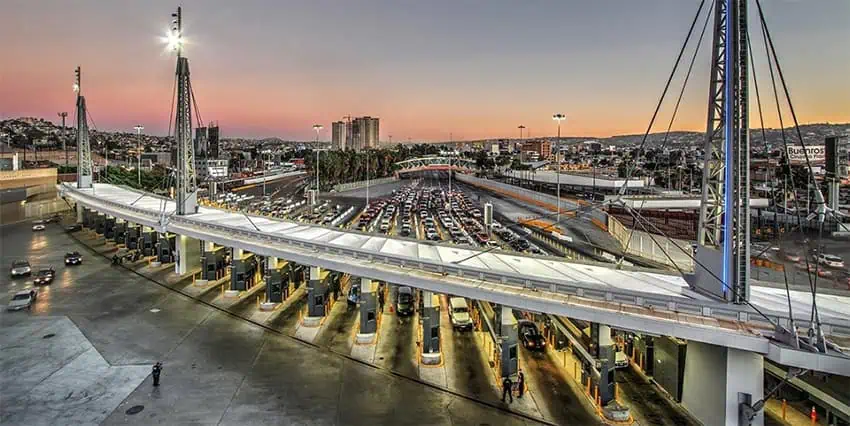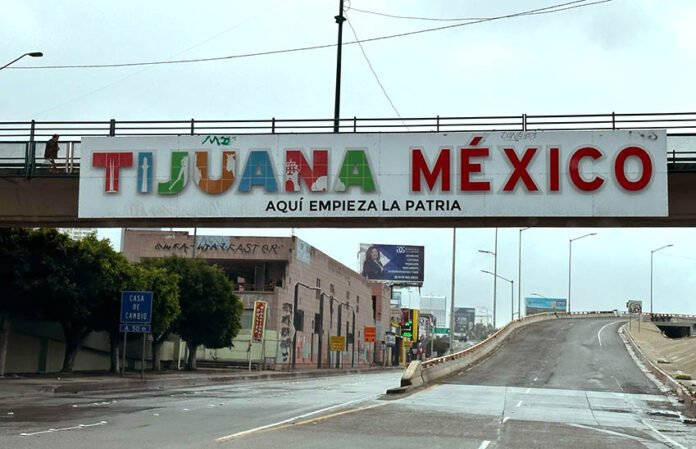Two weeks ago my wife and I had the opportunity to attend Mexico’s annual Tianguis Turístico (National Tourism Fair). For the first time ever, events for the fair were going to be held in both the United States and Mexico. We jumped at the opportunity to check out the event and see firsthand what seemed to be some great cooperation between the two countries at a time when much more coordination would be mutually beneficial.
The events were held in Tijuana and San Diego, which gave us the added benefits of checking out Tijuana for the first time as well as getting a feel for the San Diego/Tijuana metropolitan area of nearly 5 million people. The area in many ways acts like one big city, with an estimated 125,000 to 150,000 students, workers, tourists and health care patients crossing the border each and every day. I have always wondered how such a massive flow of people can co-exist alongside a significantly fortified wall.

I estimate that I have “crossed the border” over 250 times over the past 30 years, but every single time prior to this trip was in the sky via an airplane. Surprisingly, I have never had the opportunity to actually see the northern border of Mexico, much less cross it by car or on foot. I have, however, had the opportunity to see and cross the southern border.
Years ago, I crossed from Mexico into Guatemala while walking through coffee plantations in the Chiapas city of Cacahoatán with a machete-wielding local (he said it was for the snakes, I’m not so sure). Starting in Chiapas, we walked through fields of coffee plants right into Guatemala with not a fence or border guard in sight. The only way we knew we had in fact crossed the border was from white painted cement posts about every quarter mile or so. Quite an experience, but to tell at another time.
Back in Tijuana, I had the opportunity to cross the border several times, on foot and by car — thankfully with our newly hired San Diego-based writer driving instead of me.
To be clear, I am in no way intending to trivialize or minimize the journeys and struggles of so many millions of people who have crossed (or attempted to cross) the border when compared to my experience. I am also not advocating for open borders — I simply want to share my personal experiences from this trip.
Border crossing No. 1: From Tijuana to San Diego walking via the Cross Border Xpress (CBX) bridge
Upon arrival at the Tijuana airport from our local BJX airport in Guanajuato, we took the CBX. I had heard this was “the way to do it” and after a bit of confusion around if I should buy our CBX tickets separately or at the same time as our plane tickets — we did it separately — we chose this crossing option. I must say that it was a surreal experience.
Less than 15 minutes after deboarding the plane in Tijuana, we were in our U.S. rental car on our way to San Diego! We walked out of the plane, followed the CBX signage, scanned our pre-purchased CBX QR code in a machine and walked about 100 yards to the United States though an elevated tunnel. At the end of the tunnel we handed the U.S. border control agent our passports for a brief moment and literally a minute later were in the U.S. talking to the rental car company representative.
After seeing and reading so many stories about the border over the years, it didn’t even seem possible and took us a while to realize that we actually had landed in Mexico on a domestic flight and minutes later were now driving a car in the U.S.
Border crossing No. 2: Driving from San Diego to Tijuana (on two separate mornings)
I really wasn’t sure what to expect on this crossing. I have read the articles in MND about how border agents in the U.S. and Mexico have recently stepped up patrols of illegal firearms heading into Mexico from the north, so I was expecting to be stopped. We first drove through the U.S. side of the border, having to slow way down but never actually coming to a complete stop. There were lots of fancy-looking machines on one side that I guess were built for people with U.S. passports, but they weren’t working and I was told that they have never yet been operational despite having been installed over a year ago. We drove without stopping through the U.S. border, drove maybe a hundred yards in the “no man’s land” and then came to the Mexican border.

At the Mexican border, we again only had to slow down due to the all-too-familiar topes (speed bumps) greeting us to Mexico. Although Mexican border patrol agents were stopping an occasional car, we were not stopped and just rolled right through. We never once had to talk to anyone or show our passports on either side of the border. Our friend driving us said that in his several decades of driving south, he has never once been stopped. Total time from our hotel in San Diego across the border and into Tijuana was less than 20 minutes. Amazing.
Once in Tijuana, it is like we had landed on another planet — everything was different. I must say that Tijuana was better than I expected given the quite negative pre-conceived notions that I had about the city and the border area in general. It was a massive city literally mashed up against the border wall with countless restaurants, bars, strip clubs, pharmacies, banks, plastic surgery clinics, dentists, hospitals and other health care clinics. I couldn’t help but feel that this was a sad first impression of Mexico for so many Americans and equally an odd stereotype for Mexicans of what Americans are wanting to cross into another country for.
Within just a few yards of crossing into Mexico, we took a hard right turn and headed along the wall directly towards the ocean. It was a weird experience, driving along the see-through double metal wall (with U.S. soldiers actively installing razor wire in between the two walls). All within just a few hundred yards of driving one goes from U.S. commercial buildings through a militarized border zone to a new city with Viagra sold on nearly every corner.
We drove to where the wall goes out into the ocean, parked the car and walked around a bit. It was a heavy feeling — sad actually. I couldn’t help but think that the birds perched on the wall could freely go back and forth between the two countries, the fish in the water as well, but we humans haven’t been able to figure out how to live as neighbors without walls. Perhaps that sounds naive, but it’s what I thought in the moment as I put my hand on the wall and reflected on U.S.-Mexico relations.

There were pictures of kids from both San Diego and Tijuana who had created and planted a “friendship garden” together on the Mexican side of the border in 2007. A sign said that the purpose of the garden was to “create a place where people can make friends across the border.” I don’t say this in any way as a political statement or commentary, but it feels like in many ways we haven’t progressed a lot since then. I say that as a human being, not as a Republican or Democrat.
I was offered to be taken to the part of the border where family members from both sides can actually hug each other through the wall from opposite sides of the wall. I declined to see that — it would be too painful to see. Perhaps I should have gone to see it. Perhaps more people should see it.
Border crossing No. 3: Driving from Tijuana back into San Diego
This was the border crossing that I guess I was most looking forward to. Outside of the comfy confines of the CBX tunnel bridge, what would it be like to cross back into the United States? We have all read the recent headlines — the border has been sealed nearly shut, very few illegal immigrants are crossing anymore and both Mexico and the U.S. have sent troops to the border to assist in controlling and stopping drug and human trafficking.
It feels like half of Tijuana’s streets are actually just lanes preparing and positioning you to cross the border. Having Global Entry, we went with our friend into the SENTRI lines. He confidently told us that, in several decades, he has never once been stopped for inspection.
As we approached the U.S. border, we handed our friend our passports and he handed them and his Global Entry/SENTRI card to the border patrol agent. She immediately asked us, “Where are the other two SENTRI cards?
“My wife and I both have Global Entry and the new passports with chips in them,” I responded, thinking the passport chips had the Global Entry/SENTRI card “incorporated” into them. Turns out I was wrong, very wrong… and we were waved into secondary inspection.
As we rolled into the secondary inspection area, it was now U.S. military troops telling us what to do. Troops with guns and fatigues, who told us to first very slowly drive our car through what looked like a giant airport metal detector. We then were told (not asked) to drive the car to another area and get out of the car to be questioned. Four agents did a deep inspection of our car, tapping the doors, pushing down on the seats, checking under the car, under the hood and in the trunk. Drug sniffing dogs helped. My wife and I were brought up on computer screens and asked a series of questions. The whole process took some 30 minutes.
Of course we had nothing to hide and made an honest mistake, but it felt awkward, uncomfortable, intimidating. We were always treated with respect, but it wasn’t a fun experience. Not the greatest reception back into our country either.

For those that frequently cross the border, perhaps my experiences are ones that you have seen and experienced many times before. For those that have not, it’s worth seeing, feeling and experiencing first hand.
For those of you who have been to Berlin, Germany, and seen where the wall once was — dividing a city into two separate countries — it’s hard to imagine that could have actually happened. I couldn’t help but hope that a future generation of Mexicans and Americans can someday look back and only imagine what it must have been like when there was a wall separating the communities of San Diego and Tijuana.
Travis Bembenek is the CEO of Mexico News Daily and has been living, working or playing in Mexico for nearly 30 years.
